
6 Questions to Answer when writing your Ecommerce Product Descriptions
So you’ve got your ecommerce store up and running, and you’ve got an array of amazing and enticing products just ready and waiting to be sold
But are you doing the best to make them seem as amazing and enticing to the consumer? You know they’re great, but you need to make sure your customer knows it as well.
To help you out, I will outline for you how to write a description for your product to make it ‘pop’ in six easy ways. Read on!
Who is my product for?
Chances are, your Star Trek-themed Christmas jumpers aren’t aimed at a general audience. Your target customer is going to have a niche interest, so write your product description with that in mind.
Appealing to specific interests is a great way of grabbing your customers’ attention and personalising your content. If you’re selling boutique festival wear, for example, write about this year’s hottest festivals. A good tip is to consider how you’d speak to your ideal customer face-to-face, then bring it to your description. Check out this description for a new must-have eye palette from Sephora:
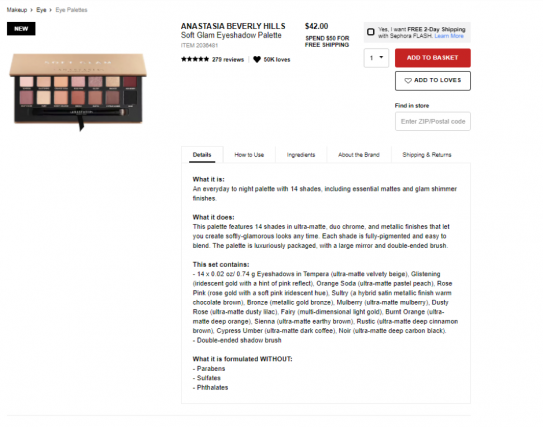
It’s packed with details a true makeup lover and aficionado will appreciate, including granular descriptions on the exact palette shades. Going into super fine detail and looking at ingredients and colour in detail, is something Sephora’s target market will fully appreciate.
Am I selling it in an interesting way?
The most important thing to know when writing a product description? Don’t be boring! We’ve all read dull copy, and we automatically switch off when we do. You want to make your product stand out from the rest, so don’t just list its qualities robotically — be passionate! Why not reference pop culture (spot the Pink Floyd reference in this Wet Shave Shoppe ad)? You can even be a little bit cheeky… within limits!
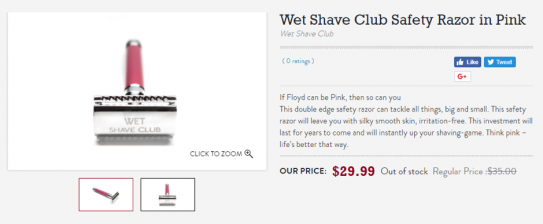
The product listing above blends useful information with lively copy, and it works great — as long as you keep your product descriptions short. Ultimately, you need to be animated, engaging and quirky — make your customers sit up and take notice!
Paperchase has plenty of fun and lively products to sell — and their descriptions match their cool stock:

Little details like calling product specifications “The Nitty Gritty” help establish an interesting and quirky brand voice that refuses to be bland.
What is my product's story?
A great way to sell your products without the customer even knowing is to talk around your product. The best way to do this is to tell them a story. Maybe your product was inspired by your travels in East Asia? Perhaps it was cooked up on a long commute one rainy Monday morning? Well-written stories breathe life into your product, making it so much more than just a photo on a page — it makes it real.
The eyewear company Warby Parker has a fascinating origin story for their brand, but also provides great inspiration for writing your own product descriptions. Natural, honest, and informal, it makes their product trustworthy. And you don’t need to be a pro either! Ecommerce platforms often come with a variety of apps available to help you craft a good product story — set up your entire store with a storytelling framework that delivers on authenticity.
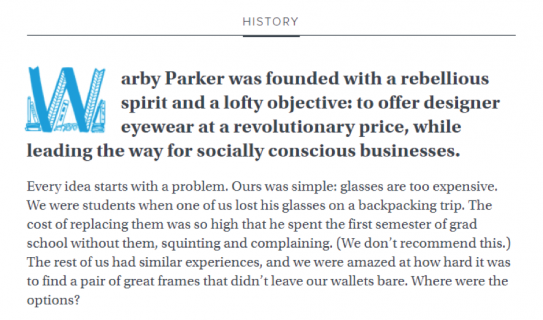
Similarly, Oliver Sweeney’s Cobbler In Chief page goes into great lengths to share the brand’s passion for quality leather, and their commitment to their family-run factory in Italy:
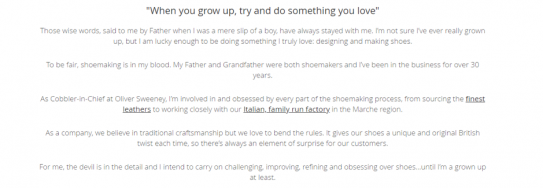
These days people love to buy from brands and businesses that they can feel truly connected to, so don’t be shy about sharing your passion and enthusiasm. You want to ensure that your offering will stand out in the sea of consumerism.
What do my customers think about my product?
Don’t just shout about your product yourself — get your audience to do it for you! Including customer reviews in your descriptions lend them credibility and create buzz. Have you ever hesitated before making a purchase, only to change your mind when a friend tells you to go for it? This works in the same way.
Once you’ve sold a product, get customer reviews and place the best ones with your product description. A great testimonial from an independent source will clinch the deal for any dithering customers. Sephora include a tonne of helpful user reviews and ratings to help people decide whether a product is right for them:
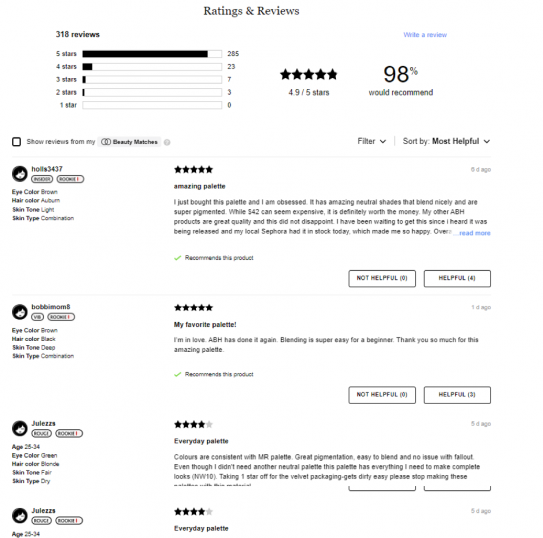
You can’t argue with 98%!
For even better results, include a review with a customer photo if you can — this will give your testimonials even more authenticity.
Think about how your product photos can also display authenticity and don’t be afraid to go DIY with your photos. It’s all about creating that visual brand language and ‘look’ that will make people sit up and take notice.
Am i using the right language for my product?
Crunchy. Gooey. Creamy. Your mouth is watering, right? As you can see, sensory words and phrases are fantastic ways of seducing a customer into buying your product. It doesn’t work for everything (it might be hard to make a razor sound appetising), but when it can, you need to utilise it.
When you’re writing your product description, consider your senses: how does it taste? How does it feel? How does it smell? Your printed t-shirts aren’t just soft; they’re feather-soft. Your artisan chocolate doesn’t just taste great; it tastes velvety smooth. Learn how to use sensory language and make your descriptions sparkle!
Can my customer see themselves using my product?
So a customer’s found your product and is considering buying, but they’re undecided. You need to make them see what life could be like if they do. They can’t go into a bricks-and-mortar store so experience the product in person, so use your description to do it for them. Consider this description for ThinkGeek’s portable BBQ grill briefcase:
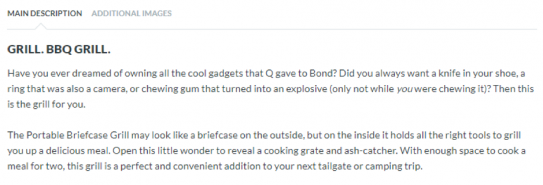
That opening paragraph paints an evocative picture. The reader imagines themselves as a slick spy, turning a briefcase into a grill with ease. Powerful stuff, right? You can do the same! Show your customer how cosy they’ll be in your knitted socks in winter. Let them imagine waking up to a steaming cup of your hand-crafted coffee. That’s how you write a product description of quality.
There you have it! Now you can go out and write great copy for your products. Next time you read a good description, stop and consider what makes it so good — then do the same. Think about your target customer and write for them. Be lively and appealing, and most of all passionate. If you’re enthusiastic about your product, then your customers will be too.
Victoria Greene is a freelance writer and branding consultant. She manages her own blog, Victoria Ecommerce, updating it with news on the latest trends in marketing, design, and ecommerce. Victoria has a passion for helping store owners get the most from their brands — it’s all about being real.